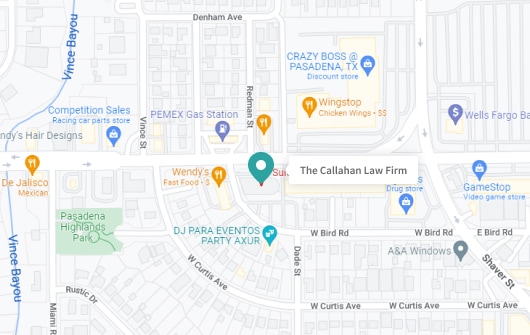5 Deadliest Highways In Texas

Traveling through Texas often means relying on its extensive network of highways. However, some of these vital transportation routes have gained a grim reputation for being among the deadliest in the state. From commercial traffic to treacherous weather conditions, these highways demand heightened caution from drivers.
With this comprehensive list, we’ll delve into the roads that have claimed far too many lives, shedding light on their unique challenges, defining the factors contributing to their notoriety, and offering insights for those seeking legal recourse in the aftermath of tragic accidents.
1. Interstate 10 (I-10)
Interstate 10 has earned a notorious reputation as one of the deadliest highways in the state. With a staggering number of lives lost each year, the I-10 freeway has consistently ranked among the top highways in the state of Texas for fatal accidents. The following factors are the main contributors to the treacherous nature of this road:
Heavy Commercial Traffic
As a major east-west corridor, I-10 serves as a crucial route for long-haul truckers transporting goods across the country. The presence of these large vehicles, often traveling at high speeds, increases the risk of catastrophic collisions.
Unpredictable weather patterns
Torrential downpours, ice storms, and dense fog can significantly reduce visibility and traction, increasing the likelihood of accidents. Drivers must remain vigilant and adjust their driving habits accordingly, as even a momentary lapse in attention can have devastating consequences.
Driver Fatigue
Due to the nature of this interstate, it is used as a regular transportation route for long-haul truckers. The lengthy hours of driving lead to truck drivers feeling fatigued, inhibiting their driving ability and resulting in tragic incidents.
2. Interstate 35 (I-35)
Cutting through the heart of Texas, the high traffic volume and numerous intersections have made it a hotspot for catastrophic collisions. According to the Texas Department of Public Safety, I-35 sees an alarming number of multi-vehicle crashes, including those involving commercial trucks.
As vehicles merge and exit at various points, the potential for miscommunication, misjudgment, and sudden lane changes increases exponentially. This heightened risk is further compounded by the presence of commercial trucks, which require significantly longer stopping distances and have larger blind spots.
4. Interstate 45 (I-45)
Connecting the cities of Dallas and Houston, Interstate 45 is a vital transportation artery that has seen its fair share of tragic accidents. According to the Texas Department of Transportation, the I-45 freeway is ranked among the most dangerous highways in Texas for fatal collisions.
In urban areas, the high volume of traffic on I-45 can lead to gridlock and increased driver frustration, contributing to aggressive driving behaviors and road rage incidents. Distracted driving, such as texting or using handheld devices, is another significant risk factor, as even a momentary lapse in attention can result in catastrophic consequences at high speeds.
The highway’s rural stretches present their own set of hazards, including the potential for wildlife collisions and limited emergency response resources. Drivers on these remote sections must remain vigilant and adjust their speeds accordingly, as even a minor mishap can have severe consequences due to the lack of immediate medical attention.
3. U.S. Route 83
Spanning the length of Texas from the border with Mexico to the Oklahoma state line, U.S. Route 83 is a frequently used route for both personal and commercial vehicles. However, its rural stretches and high-speed limits have contributed to its reputation as one of the deadliest highways in the state.
One of the primary dangers associated with U.S. Route 83 is the vast expanse of open roads that stretch across rural areas of the state. With fewer intersections and traffic signals, drivers on these long stretches may be tempted to increase their speeds, potentially exceeding safe limits.
This route has seen a concerning number of high-speed crashes, many of which resulted in fatalities. Drivers on this highway must remain vigilant and exercise caution, especially in remote areas where emergency services may be limited.
5. U.S. Route 285
Traversing the vast expanse of West Texas, U.S. Route 285 has led to a disproportionate number of crashes involving large commercial vehicles, often resulting in catastrophic consequences. The combination of long stretches of open road, inclement weather conditions, and driver fatigue contribute to the hazardous nature of U.S. Route 285, requiring heightened awareness and caution from all motorists.
The presence of large commercial trucks on U.S. Route 285 poses a significant risk to other motorists. These massive vehicles have longer stopping distances, larger blind spots, and greater potential for causing severe damage in the event of a collision. The long stretches of open roads can lead to driver fatigue, a major contributing factor to truck-related accidents.
Weather conditions on U.S. Route 285 can also be unpredictable and treacherous, with sudden storms, high winds, and icy conditions challenging even the most experienced drivers. These factors can significantly reduce visibility and traction, increasing the risk of jackknifing, rollovers, and other incidents involving commercial trucks. Given these factors, it’s no surprise that U.S. Route 285 is often cited as the deadliest highway in Texas
Your Safety on Texas Highways: Legal Insights and Support
As you navigate these treacherous highways, it’s essential to prioritize safety and exercise due diligence on the road. However, even the most cautious can find themselves in a tragic accident caused by the negligence of others. If you or a loved one has been impacted or severely injured by a serious accident on one of these deadly highways, know that we are here to help.
Our dedicated team of car accident attorneys and truck accident attorneys at The Callahan Law Firm is committed to fighting for the rights of accident victims and ensuring they receive the compensation and justice they deserve. Contact us today and schedule a cost-free consultation, and let us help.
FAQ
Where is the Death Highway in Texas?
Death Highway, known as U.S. Highway 285, runs through West Texas, primarily in the Permian Basin region, which is heavily trafficked by oilfield trucks and workers. This route is marked on the Texas highway map as a high-risk area.
How many people died on the 285 highway in Texas?
The 285 highway, also known as Death Highway, has unfortunately seen a significant number of fatalities over the years. For precise and current statistics, please refer to the latest reports from the Texas Department of Transportation.
How many days did Texas go without a fatality on the highway?
Tragically, Texas has not had a day without a fatality on its highways in over two decades. For detailed information, the Texas Department of Transportation provides updated statistics on highway fatalities.

Michael S Callahan is an attorney and founder of The Callahan Law Firm. He focuses his practice on representing individuals and families in personal injury cases involving motor vehicle and truck accidents, workplace accidents and defective products. With over 25 years of experience, he is dedicated to fighting on behalf of people whose lives have been forever altered by the negligence and carelessness of corporations and individuals. Originally trained as a mechanical engineer, Michael has been practicing law and fighting for justice for those who need it most since 1994. He is board-certified in Personal Injury Trial Law by the Texas Board of Legal Specialization and a member of various esteemed legal associations. Outside of work, Michael enjoys spending quality time with his family, outdoor activities, and continually striving to improve as a trial lawyer and human being.











